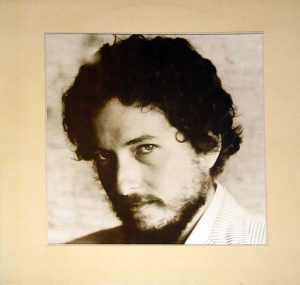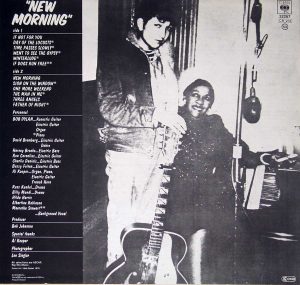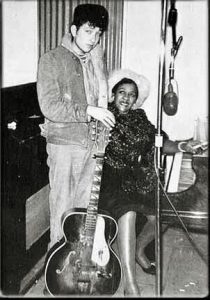By Patrick Roefflaer
This is article number 30 in our series reviewing the art work of Dylan’s albums. An index to all the articles can be found here.
- Released: October 19,1970
- Photographer Len Siegler
- Art-director ?
Bob Dylan & Victoria Spivey
“I think one of the best records that I’ve ever been a part of was the record made with Big Joe Williams and Victoria Spivey. Now that’s a record that I hear from time to time and I don’t mind listening to it. It amazes me that I was there and had done that.”
Bob Dylan , Rolling Stone Magazine, November 22, 2001
Barely three months after Self Portrait, there is a new Dylan album in the shops. The press regards the title as telling: New Morning, a new start after the double album that has been reviewed as the nadir in the career of the great singer-songwriter.
Obviously, the man himself denies such a thing. Regarding that title, he reminisces in his Chronicles, Volume One (2004): “[The producer Bob] Johnston had asked me earlier, “What do you think you’ll call this record? ” Titles! Everyone likes titles. There’s a lot to be said in a title. I didn’t know, though, and hadn’t thought about it. […] I had just heard the song “New Morning” on the playback and thought it had come out pretty good. New Morning might make a good title, I thought and then I said it to Johnston. “Man, you were reading my mind!” That’ll put them in the palm of your hand – they’ll have to take one of them mind-training courses that you do while you sleep to get the meaning of that.”
Dylan immediately adds that he already had an idea for the cover: “…a photo of myself and Victoria Spivey. […] I knew that this photo would be on the cover before I recorded the songs. Maybe I was even making this record because I had the cover in mind and needed something to go into the sleeve.”
Said photo was taken on March 2, 1962, in the Cue Recording Studio in New York. That day Dylan was invited to play harmonica during a session of Victoria Spivey with Big Joe Williams.
Victoria Spivey is a singer who began her career in 1918, at the tender age of 12, and enjoyed success in the vaudeville and blues genres. Unlike many other musicians, the Great Depression didn’t stop her career, as she had moved on by then to musical films and stage shows. Spivey retired from show business in 1951.
Towards the end of that decade however, jazz historian Len Kunstadt lured her out of retirement and gave her a regular column in his Record Research magazine, entitled “Blues Is My Business”.
Kunstadt became her agent, manager and her husband. To give her career a second wind they founded their own record label: Spivey Records. The aim was to regularly release albums by Spivey, each time collaborating with different musicians.
One of the first sessions was in March 1962. Big Joe Williams, who happened to be in town for a two week stint in Gerde’s Folk City, was invited. The Delta blues singer/guitarist is probably best known for popularizing the blues songs “Baby Please Don’t Go” (1935) and “Crawlin ‘King Snake” (1941).
Big Joe brings a guest to the studio: a young aspiring folk singer he met in October 1961, when playing a previous series of gigs at Gerde’s. During that two week period, Bob Dylan frequently sat in to accompany the singer-guitar player on harp (harmonica) and backing vocals. By the end, they were billed as Big Bill and Little Joe. The two got on so well, that Dylan states in his Chronicles Volume One: “I´d played with Big Joe Williams when I was just a kid.”
 The album Dylan so fondly remembers is Three Kings and a Queen, released on Spivey Records in October 1964. The queen of course is Victoria, while the three kings are guitarist Lonnie Johnson, pianist Roosevelt Sykes and Big Joe Williams. Dylan can be heard playing harp behind Williams driving guitar and raspy vocals on “Sitting on Top of the World” and “Wichita”.
The album Dylan so fondly remembers is Three Kings and a Queen, released on Spivey Records in October 1964. The queen of course is Victoria, while the three kings are guitarist Lonnie Johnson, pianist Roosevelt Sykes and Big Joe Williams. Dylan can be heard playing harp behind Williams driving guitar and raspy vocals on “Sitting on Top of the World” and “Wichita”.
During the session two photographs were made: the one, Dylan wanted on the cover of New Morning eight years after the fact, portrays a confident Bob standing with his right hand on Williams’ beat up Supertone guitar (converted into a 9 string). Sitting next to him, in front of the piano is Victoria Spivey, beaming up at the young man, looking immensely pleased.
There’s a second photograph, in which all those present are shown: Dylan, Spivey, Kunstadt and Williams.
New Morning

Visit my website https://vinyl-records.nl for complete album information and thousands of album cover photos
In late Summer 1970, plans have obviously changed, a photo of Bob Dylan face is made for the front sleeve of the New Morning album. The bearded Dylan gives the listener a serene and determined look.
The photo is printed in sepia and edged with a pale brown-orange-ish frame. For the third time in a row, both the title and the name of the performer are missing on the front of the album’s sleeve. Perhaps Dylan just wants to give his fans a hard time?
In the booklet of The Bootleg Series, Vol 1-3 (1991) in a very similar photo is printed,but this time in colour. So we learn that the vest he is wearing is blue and white striped.
But there’s more. When the 1962 photo of young Bob on the back is mirrored and put next to the 1970 Bob of the New Morning sleeve, there’s a similarity that simply cannot be coincidence. Exactly the same angle of the face is used and exactly the same look on both faces.
Len Siegler?
Who wielded the camera is unclear. Dylanologist Michael Gray mentions Len Siegler as a photographer in his Bob Dylan Encyclopedia (2006), but notes that the original remained in the possession of Len Kunstadt for many years. That also matches the credits on the cover, where only Siegler is credited as photographer.
In his series of articles in The Telegraph “Looking Up Dylan’s Sleeves” (1995-1996), Rod MacBeath calls Len Siegler a “Columbia staff photographer.” There is no further information at all about the man. Specialized sites such as Allmusic and Discogs do not mention any other album sleeve to which Siegler has contributed – remarkable for a staff photographer of a record company, isn’t it? It seems like Siegler has only taken a handful of photos in his entire career, all of Bob Dylan.
In fact, in the book accompanying The Bootleg Series, Vol. 10 – Another Self Portrait (1969-1971) there’s about a dozen photographs related to Len Siegler – and yet his name is not mentioned anywhere.
This lead me to think that perhaps Len Sigler and Len Kunstadt are one and the same. In November 2018, I mailed this suggestion to Alan Fraser (from the beautiful site Searching for a Gem). After consulting Rod MacBeath (The Bridge), the following text appeared on the New Morning entry on Searching for a Gem: “[…] This leads Rod MacBeath to conclude that, because the photos from the Aug or Sep 1970 session are the only ones known to be credited to Len Siegler, he and Len Kunstadt are the same person!
I recently put the question regarding Len Kunstadt/Siegler to the spiveyrecords.com blog and got a very friendly mail back from Lisa Weiner. “I am sorry that I do not have any insight for you. Len Kunstadt was my uncle. I have never heard him referred to as Len Siegler, and there is no Siegler in my extended family. That said, Lenny certainly did things his own way, so it is possible that he decided to use another name for some reason — I do not know.”
So, I’m afraid it remains an unsolved mystery who Len Siegler is.
Notes
- The New Morning pressing on Deutsche Schalplatten has a different back cover, with the photo showing Bob and Victoria replaced with one from the mid-1960s of Dylan alone at the piano.
- There’s one more photo of Bob and Victoria together. It’s made by Rowland Sherman, at the Newport Folk Festival in 1963, where they both appeared.
- In her column for the April 1965 issue of Record Research, Spivey wrote about Bob Dylan the heading ‘Luck Is A Fortune!’:
‘If you live long enough your luck is bound to change. I was just thinking about little BOB DYLAN. The years flashed back to 1961 when I first met him at Gerde’s Folk City in Greenwich Village, New York City. He was the sweetest kid you would ever want to meet. Just a bundle of nervous energy. He would say Moms, this Moms, that Moms, always trying to get my attention, He was a doll. I was so proud of him then because he really had some talent which was just ready to explode. And did it! Just a couple of years later he was on his way to becoming a world idol in his field.
‘
Visit my website https://vinyl-records.nl for complete album information and thousands of album cover photos
Speaking about idols! Bob used to tell us all about his childhood and how he used to get next to the Chicago blues people. He had an idol too, among others, and he was none other than the great country blues singer, Big Joe Williams. A dream came true for Bob when Big Joe was here in New York for a Gerde’s engagement. Bob knew about my little record company SPIVEY and my plans to record Big Joe, and he wanted “in” too. What a sight as little Bob was carrying Big Joe’s unusual guitar to the studio! And did they play well together! Like they were together for 50 years! “Come On Big Joe Little Junior, Play your harp.” That’s the way Big Joe proudly gave Bob the cue to “take off” on one of the titles. Yes, this was Bob before Dame fortune was to reward him for his great talent.
‘When I see him now he still gives me that big baby kiss and hug. He’s still the same Little boy to me and I am so happy for him. On a recent Les Crane TV show Bob was simply great. I believe he could become a great comedian in addition to his writing and singing.
‘So Bob! keep up the good work and stay the same young man you were in 1961, and you won’t have to look back.’
Untold Dylan
We are approaching article 2000 on this site. You can find indexes to series linked under the image of Dylan at the top of the page and some relating to recent series on the home page.
Although no one gets paid for writing, publishing or editing Untold Dylan, it does cost us money to keep the site afloat, safe from hackers, n’er-do-wells etc. We never ask for donations, and we try to survive on the income from our advertisers, so if you enjoy Untold Dylan, and you’ve got an ad blocker, could I beg you to turn it off while here. I’m not asking you to click on ads for the sake of it, but at least allow us to add one more to the number of people who see the full page including the adverts. Thanks.
As for the writing, Untold Dylan is written by people who want to write for Untold Dylan. We welcome articles, contributions and ideas from all our readers. Although no one gets paid, if you are published here, your work will be read by a fairly large number of people across the world, ranging from fans to academics. If you have an idea, or a finished piece send it as a Word file to Tony@schools.co.uk with a note saying that it is for publication on Untold Dylan.
We also have a very lively discussion group “Untold Dylan” on Facebook with around 8500 active members. Just type the phrase “Untold Dylan” in, on your Facebook page or follow this link And because we don’t do political debates on our Facebook group there is a separate group for debating Bob Dylan’s politics – Icicles Hanging Down



Photo obviously a composite of images.
Hi Grl,
I honestly have no idea what you’re talking about.
Care to explain?
Perhaps ‘Grl’ considers the Spivey photo a fake???? Beats me too what is meant by the comment.